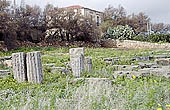| enter keyword to search: |
|
Images db
|
|
|
Articles db
|
|
|
|
|
|
|
| Sicilian Archaeological Sites |
|
Sicilian archaeological legacy is immense with its celebrated and more remote remains of the many civilizations that have passed across this land.
Sicily occupies a crucial position in the Mediterranean. From the Iron Age to the Augustan Empire it was centre of affairs at the heart of many cross-currents of trade, people, and ideology that flowed unceasingly through the ancient period. The island was home to many people: Phoenicians, Greeks, Romans settled there. Then successive groups of Arabs, Byzantine, Normans and finally the Spaniards conquered the islands leaving their monumental evidence and the archaeological finds in which the island abounds.
Paleochristian archaeological sites - Cava d’Ispica in the province of Ragusa, a limestone valley with a dry riverbed with extensive views over the surrounding countryside and beautiful Mediterranean vegetation, it is split in two parts, the first is called Larderia, one of the greatest Sicilian hypogeum cemeteries, with numerous Paleochristian catacombs (4th-5th century) and a small settlement with ancient cave-homes, a small cave-church St. Nicholas with Byzantine frescoes, interesting also the tombs of the nearby Baravitalla landholding, in the southern site, named Parco Forza, there are some sepulchral pits and grotto-stables, connected to the neighbouring Palazzo Marchionale, the Centoscale, a tunnelled staircase that reaches the river, also interesting the cave church Santa Maria della Cava.
Pantalica, in the Anapo Valley – Siracusa province – conserves the ruins of the ancient Hybla (13th-8th century BC), it consists of a large necropolis carved into the rock and the monumental Anaktoron, similar to a Mycenaean construction, on an elevated position dominating the underlying river valley.
Phoenician Mozia |

|
Phoenician settlement of Mozia (7th century BC), on the island of the same name, was the main Phoenician city in Sicily, it retains remains of an ancient shrine, a necropolis, a tophet (where children were sacrificed to Gods), and a house called ‘casa dei mosaici’ (the mosaic-house) with floor mosaics with naturalistic scenes like four groups of beasts attacking a deer or with geometrical and vegetables themes.

|
Syracuse
|
Eryx (Erice) was founded by the mysterious Elymian, allegedly refugees from Troy, considered to be the earliest settlers of Sicily, the remains include parts of the city walls still retaining three Norman gates and a medieval fortress known as the Venus Castle.
Ancient Greek sites
Syracuse, founded by Greeks in the early 7th century, the 5th century BC theatre, on the Temenite hill, offering a splendid view, is the biggest ancient Greek theatres in Sicily, nearby stands the Latomia del Paradiso (Quarry of Paradise), a deep stone quarry, where especially noted is the Ear of Dionysius, an ear-shaped cave used in the past as prison and the cave called "Grotta dei Cordari".
The ancient city of Segesta features both an exquisite Doric temple and classic hilltop theatre overlooking the Gulf of Castellammare.
Archaeological Park of Selinunte, ancient Greek polis, preserves remains from temples and extensive ruins which were, fortunately, never built over.
Morgantina in the area of Aidone, Enna, during the Greek and Roman periods it was an important commercial hub thanks to its central location in the trade routes, the major remnants consist of the agorà, with ruins of shops kilns, a shrine, and of a market from the Roman age, most of the site’s relics are preserved into the Museum of neighbouring Aidone.
Morgantina |

|
Agrigento Temples Valley, the best preserved and, certainly, most notorious and outstanding archaeological site in Sicily.
Santa CroceCamerina, in the coast of the province of Ragusa, founded as a colony of Siracusa it suffered assaults from both the Carthaginians and the Romans who finally destroyed it in 598 BC, excavations have revealed the remains of a temple dedicated to Athena (incorporated in the building which now houses the museum), three necropolises and remains of ancient ‘Casa dell’Iscrizione’. The museum displays all the relics coming from the numerous wrecks in the sea off Camarina.
The ancient Tyndaris (Tindari) with a well-maintained Greek Theatre on a promontory overlooking a dramatic coastal scenery.
Taormina, the ancient Tauromenion, boasts outstanding relics like the world famous Greek Theatre, on a hill overlooking a breath-taking landscape, with the mighty mount Etna and the Jonio see, the theatre retains the auditorium divided into nine sections and a double portico with several niches and columns, the stairs originally comprised two orders of columns which are largely ruined today. Relics of a small Roman Theatre dating from the 2nd century BC, a Hellenistic-Roman building called 'Naumachia', that could probably be a 'Ginnasio', a long wall containing numerous niches of various dimension that preserves a cistern with two aisles and pillars.
Naxos, is the most ancient of Sicilian Greek colonies. Founded by Chalcidians in 734 BC, who successively expanded into other areas of Sicily, it was destroyed by Dionysius I in 403 BC. The Archaeological Park preserves a 5th century urban settlement with an impressive road-system and relics of houses; worth-seeing are the Chalcidian Shrine (7th century BC), the remains of two temples one of which dedicated to Aphrodite (7th-5th century BC), remnants of kilns (4th-5th century) attesting to the Byzantine presence. The museum displays innumerable relics that have been excavated in its territory. Besides the historical importance, the city offers you beautiful landscape architectural, as well as naturalistic elements.
Eloro established by the Syracuse in the 7th century BC by the mouth of the Tellaro river, remnants include: sections of 6th century BC walls, the agorà, a shrine dedicated to Demetra, a theatre and "Pizzuta" a funerary monument probably dating from the Hellenistic Age.
Camarina |

|
|
Related Pages
-
-
-
-
-
-
-
-
|
|
|
 |
|
|



